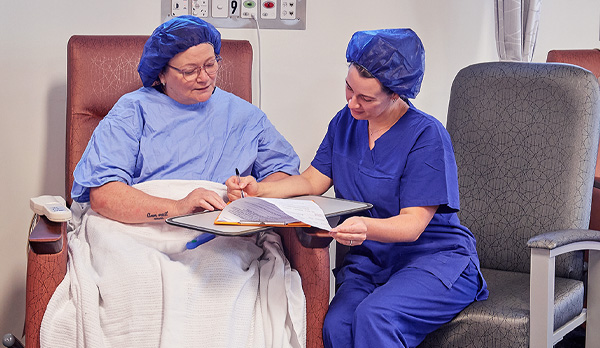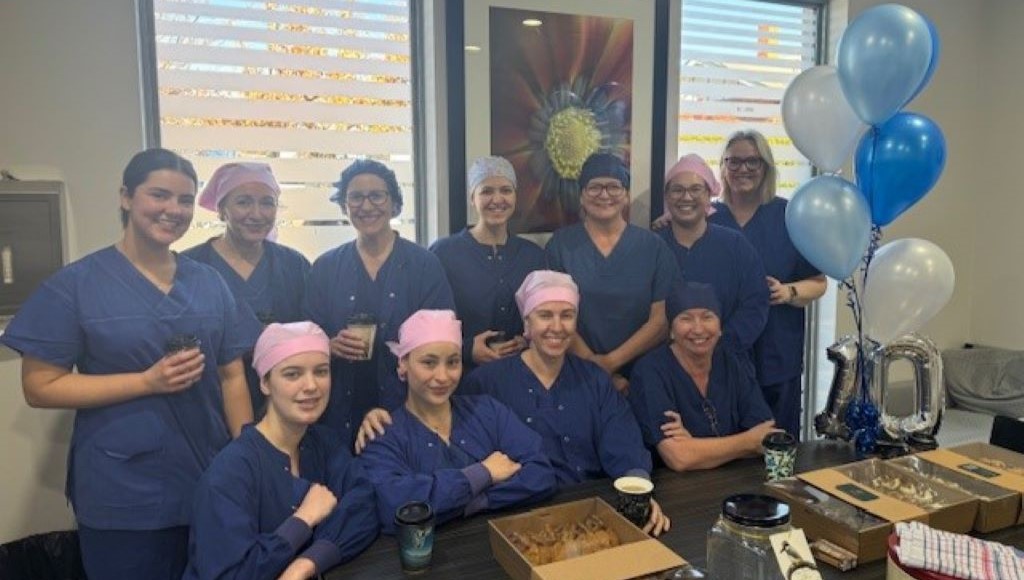Welcome to Riverina Day Surgery
In keeping with superior surgical techniques, Riverina Day Surgery’s nursing staff are highly trained, hand-picked professionals who are committed to providing the very best nursing care in a friendly, relaxed atmosphere. Throughout your stay at Riverina Day Surgery, your personal dignity and privacy will be respected and your individual wishes will be considered at all times.

- Patient Information
- Find a Doctor
- Patient Feedback
- Australian Charter of Healthcare Rights
- Patient Safety and Quality
- Governance
- Online admissions
- Our Procedures
Adenoidectomy is a surgical procedure performed to remove the adenoids (a mass of lymphoid tissue located behind the nasal passages).
Laryngoscopy refers to a procedure used to view the inside of the larynx (the voice box).
A turbinectomy is a procedure to relieve nasal congestion in which some or all of the turbinate bones in the nasal passage are removed.
In chronic cases of otitis media with effusions present for months, surgery is sometimes performed to insert a grommet, called a “tympanostomy tube” into the eardrum to allow air to pass through into the middle ear, and release any pressure build up and help clear excess fluid within.
An anal fissure is a small tear or ulcer in the skin around the opening of the anus. Anal fissures can be treated with several different types of surgery, the most common of which are lateral internal sphincterotomy (a small incision is made in the internal anal sphincter muscle to relax it) or a fissurectomy (in which the surgeon removes all damaged skin around the fissure to enable the wound to heal).
A Colonoscopy is an examination of the colon (large intestine) using a long, thin, flexible tube with a camera called a colonoscope.
Flexible sigmoidoscopy is a test that uses a flexible, narrow tube with a light and tiny camera on one end, called a sigmoidoscope , to look inside the rectum and the lower, or sigmoid, colon.
A gastroscopy is an examination of the upper digestive tract (the oesophagus, the stomach and duodenum) using a long, thin, flexible tube with a camera called a gastroscope.
Haemorrhoid banding, or rubber band ligation (RBL) is a relatively non-invasive procedure where elastic bands are applied to the base of the haemorrhoids in order to cut off blood supply and flatten the haemorrhoids.
A haemorrhoidectomy is the surgical removal of haemorrhoids under anaesthetic.
This procedure refers to the infusion of an iron and saline mixture directly into the bloodstream through the use of an IV.
The National Bowel Cancer Screening Program (NBCSP) invites Australians aged over 50 to screen for bowel cancer using a free, simple test at home. Australia has one of the highest rates of bowel cancer in the world. Around one in 23 Australians will develop bowel cancer during their lifetime.
Click here for more information
There is no one recommended screening test for gastric cancer. Screening and diagnostic tests for oesophageal and gastric cancer can be performed via endoscopy. Other screening methods include barium swallow/upper GI x-ray or endoscopic ultrasound.
Oesophageal Dilation is a procedure performed to stretch or widen the oesophagus using weighted dilators.
Polyps are growths on the inside of the colon or gastrointestinal tract and are very common. A polypectomy can be performed during a colonoscopy or gastroscopy procedure.
Carpal tunnel release is a surgery used to treat carpal tunnel syndrome. There are two types of Carpal Tunnel Release Surgery; Endoscopic and Open.
Endoscopic carpal tunnel release surgery is the use of an endoscope to cut the transverse carpal ligament. The endoscope is usually inserted through a small incision in the palm.
During the open surgery, the surgeon will cut the carpal ligament to relieve pressure on the median nerve, and make more space for the nerve and tendons.
Laparoscopic hernia surgery is a surgical procedure in which a laparoscope is inserted into the abdomen through a small incision to repair the hernia.
Open hernia repair is the procedure performed to repair hernia by pushing the hernia back in place through an abdominal incision.
Laparoscopic Cholecysectomy is the removal of the gallbladder through ‘key hole surgery.’
Surgical removal of lesions is a simple procedure undertaken to remove growths such as lesions, tumours or moles for either medical or cosmetic reasons.
Wedge resection toenail is the surgical treatment for an ingrown toenail.
Bladder neck injections are injections of bulking agents into the urethra to improve the seal at the bottom of the bladder. This procedure is usually performed as a treatment for stress incontinence.
Dilation and curettage (D&C) is a procedure to remove tissue from inside the uterus. A D&C is usually performed to diagnose and treat certain uterine conditions.
Endometrial Ablation is a procedure that surgically removes the lining of the uterus in order to reduce, or stop menstrual flow.
A hysteroscopy is the procedure in which a thin, lighted tube is used to examine the inside of the uterus and cervix. Hysteroscopy can be used in the diagnosis and treatment of several conditions such as abnormal bleeding, polyps or tumours inside the uterus, and adhesions.
Also known as ‘key-hole’ surgery, a laparoscopy is the procedure in which a laparoscope containing a fibre-optic camera and/or surgical heads is inserted through a small incision in the abdomen. Some of the many problems which can be diagnosed or treated by laparoscopy are infertility, reproductive problems, ectopic pregnancy, urinary disease and liver and pancreas cancer.
LLETZ stands for large loop excision of the transformation zone (of the cervix). In this procedure, the surgeon will remove a small segment of the cervix (the lower part of your womb or uterus) for examination.
IVF was originally developed to treat women with irreparably damaged Fallopian tubes. It allows those stages of conception which usually occur in the tubes – oocyte (egg) collection, fertilization and early embryo development – to be performed in the laboratory i.e. in vitro. It is now widely used to treat most forms of infertility including endometriosis, male infertility, immunological infertility, and idiopathic or unexplained infertility.
Oocyte Pick Up (OPU) is the surgical procedure in the IVF cycle in which the eggs are collected or retrieved.
A sperm aspiration procedure from the epididymis (PESA).
Sperm aspiration from the testicle (TESA).
A blepharoplasty is a procedure which removes excess or sagging skin from upper and/or lower eyelids. The surgery is usually performed for cosmetic reasons however; it can improve sight in patients whose eyelids are obscuring their vision.
A canthoplasty is a surgical procedure that tightens the area around the eye in order to correct a drooping appearance, and create an upward slant in the outer corner of the eye.
Ectropion is a medical condition where the eyelid folds outward. Corrective surgery involves the removal of a small piece of the fold to tighten the muscles in the area.
Entropion is a medical condition where the eyelid folds inward. Corrective surgery involves the removal of a small piece of the fold to tighten the muscles in the area.
Excision of lesions is a procedure to remove growths such as lesions, moles and tumours from the skin, sometimes accompanied by frozen sections and followed by sutures or a graft. The most common reason for undertaking this procedure is for the removal of skin cancers such as Basal Cell Carcinoma which is the most common skin cancer on the face.
Ptosis is a drooping of the upper eyelid. Corrective surgery is performed by tightening the levator muscle through an incision in the normal crease in the upper lid.
A wedge excision is a procedure which removes cancers from the edge of the eyelid.
Cataract surgery is the surgical replacement of a cloudy lens with an artificial intraocular lens (IOL) implant to restore vision. The cloudy lens is broken up and removed with an ultrasound probe through a very small incision in the eye, and the artificial lens is inserted.
A penetrating keratoplasty, or corneal transplant, replaces diseased or scarred corneal tissue with healthy tissue from an organ donor. Corneal transplants can treat a number of conditions such as keratoconus, Fuchs’ dystrophy, corneal infection, corneal dystrophy and corneal injury or trauma.
A pterygium is a growth of blood vessels and fibrous tissues covering the surface of the eye due to over-exposure to sunlight over an extended period of time. A pterygium is treated with a surgical excision and an auto-conjunctival graft.
Squint surgery involves tightening the extraocular eye muscles to change the eye position in order to correct a turned eye.
A temporal artery biopsy is the most common diagnostic test for giant cell arteritis.
Glaucoma is characterised by elevated intraocular pressure associated with optic cupping and visual field loss. Trabeculectomy surgery lowers intraocular pressure by forming a new drainage to allow fluid to escape from the eye.
Vitrectomy is a surgery which removes the vitreous gel from the eye to assist in the repair of retinal detachments, macular holes and retinal membrane surgeries.
Oral pathology is the study of oral diseases. Diagnostic procedures include conventional biopsy, brush biopsy, and exfoliative cytology.
When wisdom teeth have the potential to cause problems or become impacted, they may be removed surgically. In the procedure, the surgeon makes a small incision and extracts the tooth with forceps.
A tooth extraction is the removal of a tooth from the dental alveolus (socket) in the alveolar bone.
Anterior cruciate reconstruction (ACL reconstruction) is a common procedure tin which a graft is used to reconstruct the ligament in the knee.
Acromioplasty is an arthoroscopic procedure used to treat impingement or bursitis of the shoulder.
An arthroscopy is a procedure in which an endoscope is inserted in a joint through a small excision in order to diagnose and treat a number of conditions. An arthroscopy can be performed on a knee, shoulder, wrist or ankle.
Endoscopic carpal tunnel release surgery is the use of an endoscope to cut the transverse carpal ligament. The endoscope is usually inserted through a small incision in the palm.
Carpal tunnel release is a surgery used to treat carpal tunnel syndrome. During the surgery, the surgeon will cut the carpal ligament to relieve pressure on the median nerve, and make more space for the nerve and tendons.
Dupuytren’s contracture is the development of a fibrous connection between the finger tendons and the skin of the palm resulting in a forward curvature or ‘clawing’ of one or more fingers. Treatment for Dupuytren’s contracture includes needling, injections and surgical procedures to sever the tissue causing the contracture.
Lateral release surgery is a procedure performed on the knee to realign the patella (kneecap). It is usually performed as an arthroscopic procedure.
Meniscal repair is a surgical procedure performed to repair torn knee cartilage.
Metatarsophalangeal (MTP) Joint Fusion is a surgical procedure in which the MTP Joint (big joint of the big toe) are fused together.
An open reduction and internal fixation (ORIF) is a procedure in which the fracture is reduced and fixated using wires, plates or screws.
Rotator cuff repair procedures are most commonly performed by arthroscopic surgery, however in some cases open shoulder surgery may be necessary. The procedure involves removing any loose fragments from the area, and then surgically repairing the tendon.
Synovectomy is the surgical removal of the inflamed synovium (the tissue lining the joint), and is usually performed with an arthroscopy. The surgery is usually performed in cases of inflammatory arthritis where there is swelling causing pain, or limiting the range of motion of the digits and thumb.
Trapeziectomy is the removal of the trapezium (cubed shaped bone in the wrist) due to pain (usually from osteoarthritis).
Trigger Finger, also known as stenosing tenosynovitis or flexor tendonitis, is a condition where one of the fingers or thumb of the hand is caught in a bent position. Surgery may be undertaken to release the tight portion of the flexor tendon sheath.
Percutaneous disc decompression procedure is typically performed on an outpatient basis and requires only local anesthetic and mild sedation, alleviating the possible complications of open surgery and general anesthesia. This invasive procedure completes the continuum of care for patients who want a minimally invasive alternative to surgery.
Chronic persistent pain can arise from any one of a number of sources in the patients back or neck. Often it may be possible to pinpoint this to one or more joints of the spine (these are called zygapophysial joints, or incorrectly, facet joints). The fine-needle injection provides useful information about potentially problematic joints that help to guide the treatment approach. The joint injection is used primarily for diagnostic purposes and is not therapeutic in nature. However, if the block is successful and it breaks the pain cycle, up to a third of people having the injection notice a useful reduction in the severity of pain for a period of days or weeks.
Radiofrequency neurotomy uses heat generated by radio waves to target specific nerves and temporarily turn off their ability to send pain signals. The procedure is also known as radiofrequency ablation.
Spinal cord stimulation (SCS) and peripheral nerve stimulation (PNS) are two common examples of neuromodulation used for the treatment of pain and have been shown to be effective treatment options for many patients with refractory neuropathic pain.
Breast augmentation is the surgical increase of the size of woman’s breasts, usually through the use of breast implants.
Breast reduction surgery also known as reduction mammoplasty is a procedure to reduce the size of large breasts through the removal of excess fat, tissue and skin from the breasts.
An excision of lesion procedure is the surgical removal of a skin lesion. Skin lesions can be any lumps on the skin including moles, cysts, warts or skin tags.
An excision of melanoma procedure is the surgical removal of melanoma (a form of skin cancer).
Labiaplasty surgery is a procedure which reduces and reshapes excess labia minora tissue of the vagina.
Sentinel node biopsy is usually performed to identify whether cancer such as breast cancer or melanoma has spread to the lymphatic system. The procedure involves injecting a tracer material to help locate the nodes, and then removing the nodes for analysis.
The circumcision procedure (for infant males) involves the use of a Plastibell (a small plastic ring) which is slipped over the glans, and the foreskin is laid over it.
A cystoscopy is a procedure in which a thin flexible tube with a camera and light on the end is inserted through the urethra and into the bladder. The procedure is most commonly undertaken to investigate the bladder for any abnormalities.
A frenuloplasty is a procedure used to treat pain caused by tight or short frenulum of the penis.
A stent removal is the removal of a ureteral stent by a surgeon using a cystoscope. A cystoscope is a thin, flexible tube with a camera and a light that is inserted through the urethra.
A TRUS biopsy is a procedure where a tissue sample of the prostate gland is taken via a rectal ultrasound probe.
A vasectomy is a surgical procedure that sterilises a man by cutting the vas deferens, which are tubes that carry sperm from the testes to the penis.
Contact Details
Opening Hours: 8:30am to 5:30pm, Monday to Friday. Our friendly personnel are always ready to assist with your enquiries.
Tel: (02) 6925 6256
Contact Person: Megan King, CEO/ Director of Nursing [email protected]
Address: 2-6 Meurant Ave, Wagga Wagga NSW 2650
- Follow Riverina Day Surgery on social





